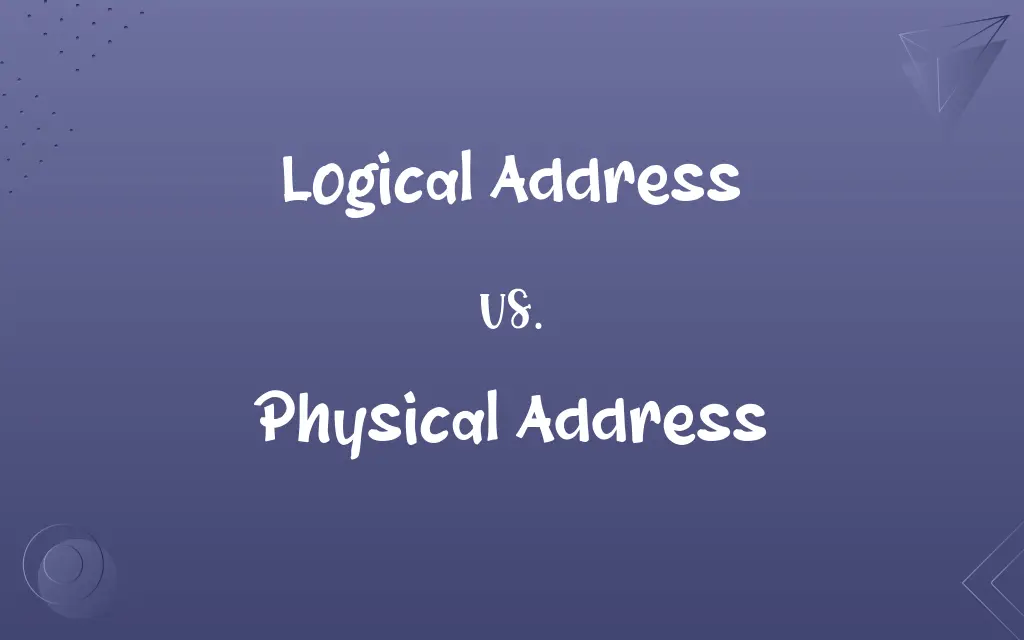Logical Address vs. Physical Address: Know the Difference

By Shumaila Saeed || Published on February 19, 2024
Logical Address is a reference used by programs to access memory. Physical Address is an cctual location in computer memory.

Key Differences
A Logical Address is generated by the CPU during a program's execution, serving as a reference to access memory locations. Conversely, a Physical Address refers to the actual location on the memory hardware where data is stored. The key distinction lies in their roles: logical addresses are used within the context of a program's perspective, while physical addresses correspond to real memory locations.
Shumaila Saeed
Feb 19, 2024
When a program runs, it uses Logical Addresses to request data, which are then translated into Physical Addresses by the memory management unit. This process ensures that the program operates within its own unique address space, distinct from the physical memory layout. Logical Addresses provide a level of abstraction, allowing programs to function irrespective of the physical memory organization.
Shumaila Saeed
Feb 19, 2024
In the realm of virtual memory, Logical Addresses play a crucial role. They allow an operating system to use disk storage as additional memory, creating an illusion of a large contiguous memory space. Physical Addresses, on the other hand, are tied to the actual RAM and storage hardware, defining where the data physically resides.
Shumaila Saeed
Feb 19, 2024
Logical Addresses are dynamic and can change each time a program is run, as they depend on the program's allocation in memory. Physical Addresses are static, fixed locations on the memory chips. This distinction is vital for understanding how different programs can operate independently without interfering with each other's memory.
Shumaila Saeed
Feb 19, 2024
The translation from Logical to Physical Addresses is invisible to the user, handled internally by the computer's operating system and hardware. This translation is a critical component of modern computing, ensuring that applications have consistent and reliable access to memory, regardless of the underlying physical memory configuration.
Shumaila Saeed
Feb 19, 2024
ADVERTISEMENT
Comparison Chart
Definition
Reference used by programs to access memory
Actual location in computer memory
Shumaila Saeed
Feb 19, 2024
Role in Memory Management
Abstract representation of memory locations
Direct representation of memory locations
Shumaila Saeed
Feb 19, 2024
Usage in Virtual Memory
Essential for mapping virtual to physical space
Directly associated with physical memory
Shumaila Saeed
Feb 19, 2024
Visibility to the User
Generally hidden and managed by OS
Not visible, but critical for hardware access
Shumaila Saeed
Feb 19, 2024
ADVERTISEMENT
Logical Address and Physical Address Definitions
Logical Address
A CPU-generated reference during execution.
The CPU utilized logical addresses to manage the program's data effectively.
Shumaila Saeed
Jan 20, 2024
Physical Address
An unchanging location in physical memory.
The cache memory stored frequently accessed data at static physical addresses for faster access.
Shumaila Saeed
Jan 20, 2024
Logical Address
An abstract representation of memory location.
The operating system mapped the logical address to a physical one for data storage.
Shumaila Saeed
Jan 20, 2024
Physical Address
A direct reference to a memory cell.
The physical address pointed to the exact location where the file was stored.
Shumaila Saeed
Jan 20, 2024
Logical Address
A virtual reference point for memory access.
The program’s variable was stored at a logical address, abstracting its actual physical location.
Shumaila Saeed
Jan 20, 2024
ADVERTISEMENT
Physical Address
A fixed memory location on a chip.
The error was traced to a corrupted value at a certain physical address.
Shumaila Saeed
Jan 20, 2024
Logical Address
An address used within a program’s scope.
Each array element was assigned a unique logical address for easy retrieval.
Shumaila Saeed
Jan 20, 2024
Physical Address
A hardware-based memory location.
The technician examined the physical address to diagnose the memory issue.
Shumaila Saeed
Jan 20, 2024
Logical Address
A memory location reference in virtual space.
The logical address allowed the software to use more memory than physically available.
Shumaila Saeed
Jan 20, 2024
Physical Address
The actual hardware location in memory.
The data was finally written to a specific physical address in the RAM.
Shumaila Saeed
Jan 20, 2024
Repeatedly Asked Queries
What is a logical address?
A reference point used by programs to access memory during execution.
Shumaila Saeed
Feb 19, 2024
What is a physical address?
The actual, hardware-based location in computer memory.
Shumaila Saeed
Feb 19, 2024
What determines a physical address?
It's determined by the memory hardware configuration and is fixed.
Shumaila Saeed
Feb 19, 2024
Who handles the translation from logical to physical addresses?
The operating system and memory management unit handle this translation.
Shumaila Saeed
Feb 19, 2024
Why are logical addresses important in virtual memory?
They allow the OS to use disk storage as additional memory, creating an expanded memory space illusion.
Shumaila Saeed
Feb 19, 2024
How is a logical address used?
It’s used by a program to request data, abstracting the actual memory location.
Shumaila Saeed
Feb 19, 2024
Can logical addresses change?
Yes, they can vary each time a program runs, based on memory allocation.
Shumaila Saeed
Feb 19, 2024
Are physical addresses static or dynamic?
They are static and tied to specific memory locations.
Shumaila Saeed
Feb 19, 2024
Can two programs have the same logical address?
Yes, as logical addresses are program-specific and abstract.
Shumaila Saeed
Feb 19, 2024
How do logical addresses affect program execution?
They allow programs to operate independently of the physical memory layout.
Shumaila Saeed
Feb 19, 2024
Is the physical address visible to the user?
No, it’s managed internally by the computer and not visible to users.
Shumaila Saeed
Feb 19, 2024
Why is logical addressing necessary?
It provides an abstraction layer, allowing programs to use memory more flexibly.
Shumaila Saeed
Feb 19, 2024
What role does the CPU play in addressing?
The CPU generates logical addresses during program execution.
Shumaila Saeed
Feb 19, 2024
Do physical addresses affect processing speed?
Yes, as accessing data directly from physical memory is faster.
Shumaila Saeed
Feb 19, 2024
Can a user modify physical addresses?
No, they are managed by the system and not modifiable by users.
Shumaila Saeed
Feb 19, 2024
What is the significance of physical addressing?
It's crucial for the actual storage and retrieval of data in memory hardware.
Shumaila Saeed
Feb 19, 2024
How does an OS manage these addresses?
The OS manages address translation and allocation for efficient memory use.
Shumaila Saeed
Feb 19, 2024
What is the impact of address translation on system performance?
It adds a layer of processing but is essential for memory protection and management.
Shumaila Saeed
Feb 19, 2024
How is virtual memory mapped to physical memory?
Through a mapping of logical addresses to physical addresses.
Shumaila Saeed
Feb 19, 2024
What happens if a logical address is incorrect?
It can lead to errors or crashes, as the program accesses the wrong memory location.
Shumaila Saeed
Feb 19, 2024
Share this page
Link for your blog / website
HTML
Link to share via messenger
About Author
Written by
Shumaila SaeedShumaila Saeed, an expert content creator with 6 years of experience, specializes in distilling complex topics into easily digestible comparisons, shining a light on the nuances that both inform and educate readers with clarity and accuracy.








































































